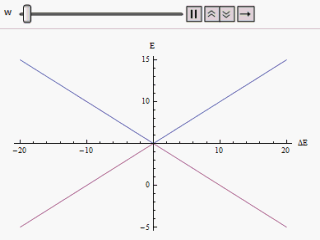
A | B | C | D | E | F | G | H | CH | I | J | K | L | M | N | O | P | Q | R | S | T | U | V | W | X | Y | Z | 0 | 1 | 2 | 3 | 4 | 5 | 6 | 7 | 8 | 9
This article has an unclear citation style. (January 2024) |

In quantum physics and quantum chemistry, an avoided crossing (sometimes called intended crossing,[1] non-crossing or anticrossing) is the phenomenon where two eigenvalues of a Hermitian matrix representing a quantum observable and depending on N continuous real parameters cannot become equal in value ("cross") except on a manifold of N-3 dimensions.[2] The phenomenon is also known as the von Neumann–Wigner theorem. In the case of a diatomic molecule (with one parameter, namely the bond length), this means that the eigenvalues cannot cross at all. In the case of a triatomic molecule, this means that the eigenvalues can coincide only at a single point (see conical intersection).
This is particularly important in quantum chemistry. In the Born–Oppenheimer approximation, the electronic molecular Hamiltonian is diagonalized on a set of distinct molecular geometries (the obtained eigenvalues are the values of the adiabatic potential energy surfaces). The geometries for which the potential energy surfaces are avoiding to cross are the locus where the Born–Oppenheimer approximation fails.
Avoided crossing also occur in the resonance frequencies of undamped mechanical systems, where the stiffness and mass matrices are real symmetric. There the resonance frequencies are the square root of the generalized eigenvalues.
In two-state systems
Emergence
Study of a two-level system is of vital importance in quantum mechanics because it embodies simplification of many of physically realizable systems. The effect of perturbation on a two-state system Hamiltonian is manifested through avoided crossings in the plot of individual energy vs energy difference curve of the eigenstates.[3] The two-state Hamiltonian can be written as
The eigenvalues of which are and and the eigenvectors, and . These two eigenvectors designate the two states of the system. If the system is prepared in either of the states it would remain in that state. If happens to be equal to there will be a twofold degeneracy in the Hamiltonian. In that case any superposition of the degenerate eigenstates is evidently another eigenstate of the Hamiltonian. Hence the system prepared in any state will remain in that forever.

However, when subjected to an external perturbation, the matrix elements of the Hamiltonian change. For the sake of simplicity we consider a perturbation with only off diagonal elements. Since the overall Hamiltonian must be Hermitian we may simply write the new Hamiltonian
Where P is the perturbation with zero diagonal terms. The fact that P is Hermitian fixes its off-diagonal components. The modified eigenstates can be found by diagonalising the modified Hamiltonian. It turns out that the new eigenvalues are,
If a graph is plotted varying along the horizontal axis and or along the vertical, we find two branches of a hyperbola (as shown in the figure). The curve asymptotically approaches the original unperturbed energy levels. Analyzing the curves it becomes evident that even if the original states were degenerate (i.e. ) the new energy states are no longer equal. However, if is set to zero we may find at , and the levels cross. Thus with the effect of the perturbation these level crossings are avoided.
Quantum resonance
The immediate impact of avoided level crossing in a degenerate two state system is the emergence of a lowered energy eigenstate. The effective lowering of energy always correspond to increasing stability.(see: Energy minimization) Bond resonance in organic molecules exemplifies the occurrence of such avoided crossings. To describe these cases we may note that the non-diagonal elements in an erstwhile diagonalised Hamiltonian not only modify the energy eigenvalues but also superpose the old eigenstates into the new ones.[4] These effects are more prominent if the original Hamiltonian had degeneracy. This superposition of eigenstates to attain more stability is precisely the phenomena of chemical bond resonance.
Our earlier treatment started by denoting the eigenvectors and as the matrix representation of eigenstates and of a two-state system. Using bra–ket notation the matrix elements of are actually the terms
- with
Antropológia
Aplikované vedy
Bibliometria
Dejiny vedy
Encyklopédie
Filozofia vedy
Forenzné vedy
Humanitné vedy
Knižničná veda
Kryogenika
Kryptológia
Kulturológia
Literárna veda
Medzidisciplinárne oblasti
Metódy kvantitatívnej analýzy
Metavedy
Metodika
Text je dostupný za podmienok Creative
Commons Attribution/Share-Alike License 3.0 Unported; prípadne za ďalších
podmienok.
Podrobnejšie informácie nájdete na stránke Podmienky
použitia.
www.astronomia.sk | www.biologia.sk | www.botanika.sk | www.dejiny.sk | www.economy.sk | www.elektrotechnika.sk | www.estetika.sk | www.farmakologia.sk | www.filozofia.sk | Fyzika | www.futurologia.sk | www.genetika.sk | www.chemia.sk | www.lingvistika.sk | www.politologia.sk | www.psychologia.sk | www.sexuologia.sk | www.sociologia.sk | www.veda.sk I www.zoologia.sk






















